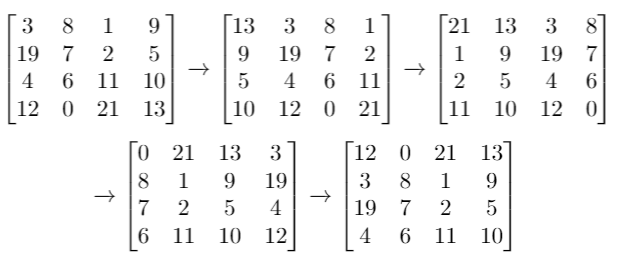- {x}
- Cells with Odd Values in a Matrix
- Reconstruct a 2-Row Binary Matrix
- Number of Closed Islands
- Maximum Score Words Formed by Letters
- Encode Number
- Smallest Common Region
- Synonymous Sentences
- Handshakes That Don't Cross
- Shift 2D Grid
- Find Elements in a Contaminated Binary Tree
- Greatest Sum Divisible by Three
- Minimum Moves to Move a Box to Their Target Location
- Page Recommendations
- Print Immutable Linked List in Reverse
- Minimum Time Visiting All Points
- Count Servers that Communicate
- Search Suggestions System
- Read More...

Shift 2D Grid
Given a 2D grid of size m x n and an integer k. You need to shift the grid k times.
In one shift operation:
- Element at
grid[i][j]moves togrid[i][j + 1]. - Element at
grid[i][n - 1]moves togrid[i + 1][0]. - Element at
grid[m - 1][n - 1]moves togrid[0][0].
Return the 2D grid after applying shift operation k times.
Example 1:

Input: grid = [[1,2,3],[4,5,6],[7,8,9]], k = 1
Output: [[9,1,2],[3,4,5],[6,7,8]]
Example 2:

Input: grid = [[3,8,1,9],[19,7,2,5],[4,6,11,10],[12,0,21,13]], k = 4
Output: [[12,0,21,13],[3,8,1,9],[19,7,2,5],[4,6,11,10]]
Example 3:
Input: grid = [[1,2,3],[4,5,6],[7,8,9]], k = 9
Output: [[1,2,3],[4,5,6],[7,8,9]]
Constraints:
m == grid.lengthn == grid[i].length1 <= m <= 501 <= n <= 50-1000 <= grid[i][j] <= 10000 <= k <= 100
Solution Explanation for Shift 2D Grid
This problem involves shifting elements in a 2D grid k times. Each shift moves elements one position to the right, wrapping around from the rightmost column to the leftmost column of the next row, and from the bottom-right element to the top-left.
The most efficient approach avoids repeatedly shifting the grid. Instead, it calculates the final position of each element after k shifts and directly places it in the resulting grid.
Algorithm:
-
Flatten the Grid (conceptually): Imagine the 2D grid as a 1D array. The index of an element
grid[i][j]in this 1D representation isi * n + j, wherenis the number of columns. -
Calculate Final Position: After
kshifts, the new index of an element originally at indexorig_idxbecomes(orig_idx + k) % (m * n), wheremis the number of rows. The modulo operator%handles the wrap-around. -
Map to 2D Coordinates: Convert the new 1D index back into 2D coordinates
(new_row, new_col)using integer division and the modulo operator:new_row = new_index / nnew_col = new_index % n
-
Populate the Resulting Grid: Place the element
grid[i][j]at the calculated(new_row, new_col)in the result grid.
Code (Python):
def shiftGrid(grid, k):
m, n = len(grid), len(grid[0])
result = [[0] * n for _ in range(m)] # Initialize the result grid
for i in range(m):
for j in range(n):
original_index = i * n + j
new_index = (original_index + k) % (m * n)
new_row = new_index // n
new_col = new_index % n
result[new_row][new_col] = grid[i][j]
return result
Time Complexity: O(m*n) - We iterate through each element of the grid once.
Space Complexity: O(m*n) - We create a new grid of the same size as the input. This could be considered O(1) if we are allowed to modify the input grid in place, but the problem statement doesn't explicitly allow that.
Code in Other Languages (briefly):
The core logic remains the same across languages. The main differences are syntax and data structure handling:
- Java: Uses
ArrayListfor the result grid. - C++: Uses
vector<vector<int>>for the result grid. - Go: Uses slices for the grids.
- Javascript/Typescript: Uses nested arrays.
The time and space complexity analysis remains consistent across all language implementations.